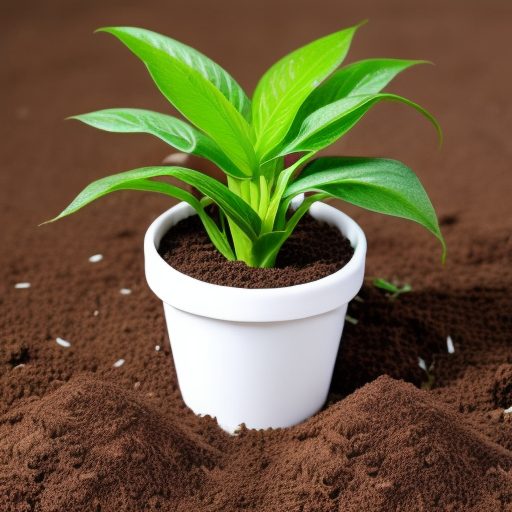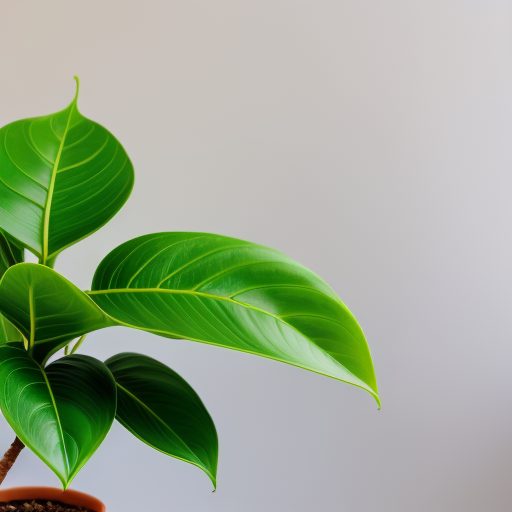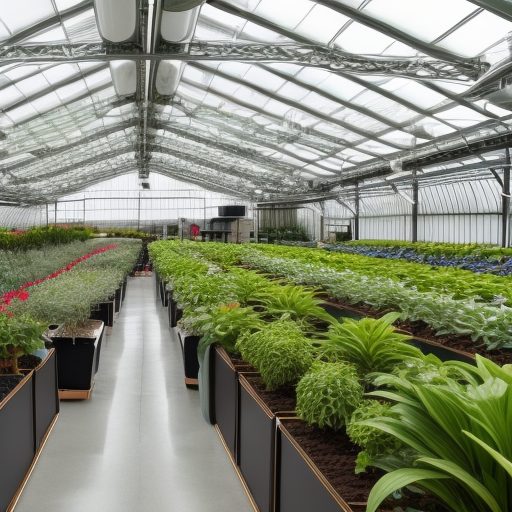HousePlantJoy is supported by our audience. When you purchase through one of our links, we may earn a small affiliate commission. As an Amazon Associate I earn from qualifying purchases. Your cost is not affected.
==================
Houseplant propagation may sound like a fancy gardening term, but it’s essentially the art of growing new plants from your existing green friends. Not only does it add more lush goodness to your indoor garden, but it’s also a cost-effective way to expand your plant collection. Plus, it’s one of those hobbies that might lead to a side hustle or even a full-blown plant business!
This green-thumb guide will walk you through various houseplant propagation techniques. It’s like learning the secrets of plant magic, where you can clone your favorite specimens or create new varieties. So, let’s roll up our sleeves and get ready to multiply your greenery for a home bursting with life and color!
Houseplant Propagation Techniques: Why?
Creating new plants from your existing ones is not only a cost-effective way to expand your green family but also a perfect opportunity to share the love by gifting starters to friends and family. And who knows, your indoor jungle might turn into a flourishing side business or a full-blown venture!
Yes, propagating houseplants from your current beauties can be a fantastic source of extra income or even a step towards a full-fledged plant business. However, remember to navigate the legal landscape carefully. Ensure you’re not stepping on any patented plant toes – for more information on this, check here.
Furthermore, local regulations on selling live plants vary, so it’s wise to brush up on the rules in your area.
Consider exploring this system if you’re intrigued by turning your plant passion into a part-time or full-time endeavor.
Today, we’re diving into the core houseplant propagation techniques, unveiling the secrets to growing and multiplying your delightful green companions. We’ll cover everything from cuttings to division, layering, plantlets, offsets, suckers, and seeds. Let’s embark on this green journey and discover how to propagate your indoor garden!
And, to make your plant parenting even more successful, we’ve got a handy, pint-sized toolset to help you nurture and care for your green buddies.
The Art of Cloning Your Green Ambitions
‘Cutting’ is your ticket to cloning your cherished plants – it’s like Mother Nature’s secret with a pair of scissors. Picture having duplicates of your beloved green companions, preserving their exact traits, and multiplying them effortlessly. ‘Cutting’ opens the door to a world where your indoor garden flourishes with plants in your favorite colors and varieties, perfect for gifting or spreading joy at home. Let’s explore stem, leaf, and root-cutting methods, revealing the secrets and species that thrive. Your indoor garden is on the brink of a vibrant transformation!
CUTTING
In cutting, we separate a part of the plant to generate a new plant. Use the cutting technique to get new plants identical to their mother plants. Like a clone, the plants produced show no variation from the parent plant. Also, hybridization is not possible.You can quickly multiply your desired color and type of plant. Then, please place it in different rooms in your house. Or, gift it to your friends.
Let’s have a look at the methods available for cutting.
STEM CUTTING
Stem cutting provides a favorite method to propagate multi-stem plants. Take about a 3 to 5-inch stem cutting from just below the node edge (a point where the leaf emerges). Now remove the leaves attached to the stem. Dip the raw edge in the rooting hormone.
Using a pencil, make a small hole in the potting soil where you duplicate your favorite plantation. Place the stem cutting in the pot. You will need to provide indirect light and damp to wet soil conditions. You should support your cutting with chopsticks or pebbles to hold it correctly.
Alternatively, many people use a simple glass of water to start the stem cutting. Ensure the water is clean, and use plain water (no chlorine). Change the water as needed to keep it clean.
Or sand works best for you. Yes, sand. I’ve included a video (scroll down) that shows how easy this is.
Precautions to Note:
- The larger wound will leave the mother plant in trouble.
- Remove the leaves quickly or wrap the stem in a plastic bag; otherwise, stomatal transpiration will result in wilting.
- In the case of succulents, cutting must be allowed to be dried to avoid rotting.
- Charcoal powdered is sprinkled over the wound to avoid microbial infections.
Species Suitable for Stem Cutting:
- Pothos
- String of pearls
- Jewel orchid
- Star jasmine
- Wandering Jew
- Monstera
Video Credit: @gardenplantswithjimputnam8653
LEAF-CUTTING
As the name indicates, cut a leaf and grow. A healthy leaf provides the best results. The leaf’s health helps determine the health of the resulting plant. Diseases spread quickly within the plant and to the new growth. Leaves indicate the health of a fully grown plant. Even a minor change in the plant’s health shows in the leaf. Leaf-cutting propagation works well for succulents. Separate a healthy leaf from the stem. Some allow it to dry for about 24 hours and let the wound heal. We apply the rooting compound and place it immediately into the selected media. Choose water, sand, or a good starting mix for success.
Keep in Mind:
- Avoid cutting an off-color, diseased, or chlorotic leaf.
- Long leaves (e.g., snake plant) can be cut into 2 to 4-inch sections. (5-10cm)
- To promote photosynthesis, keep most of the leaf above ground.
- Usually, sand or well-drained potting mixture works best for succulents.
- Vermiculite (potting mix) works well for leaf cuttings of African violets.
- For begonia, make incisions in a few veins and pin the leaf into the moist growing medium.
- If growing in water, remember that the entire leaf should not touch the water. Otherwise, it will start rotting.
Species Ideal for Leaf Cutting:
- African violets
- Wander jew
- Snake plant
- Jade plant
- Echeveria
- Begonia
- Christmas cactus
- Zamicoculcas zamifolia
ROOT CUTTING
Root cuttings involve a more extensive root section divided into smaller parts of about 2 to 4 inches. Using five or more cuts is suggested to increase the success rate. Cut the roots and place them in the soil, keeping the crown near the soil surface; new shoots can emerge quickly. Root cutting is readily taken during winter.
Rhizomes division: Zamioculcas zamiifolia
They can be cloned by dividing rhizomes. Remove the plant and tug it to divide it into two halves (you can use a knife if needed). When teasing apart, ensure that the two-division equally get all the parts, including root, leaves, and stem. Pot both the halves again and provide a favorable condition. Wait for the twin plants to be adequately established.
Bulb/tuber Division: some plants, like caladium or tuberous begonia, give off bulb/tubers. To multiply these plants, cut the tuber into small sections so that each section has an eye from where the shoots emerge. Some plants produce a new bulb with time, detach the new bulb, and plant it in the pot.
Indoor Plants for Root Cuttings:
- Achimenes
- Caladium
- tuberous begonia
- Boston Fern
- Cyclamen
- Calathea
- Gloxinia
- Zamioculcas zamiifolia
The Video Below Shows Rooting Cuttings.
Air layering is the method of establishing the root system of the stem without separating it from the already existing plant.
How to Do It?
Select the stem that can be easily pruned later when needed. Notch the stem halfway so it is still attached to its parent plant. Place a toothpick between the cut to allow rooting, and add rooting powder. A ball of moist moss is wrung out around the notch and wrapped in the plastic film. Secure the top and bottom ends of the wrapping material with a wire twist. After a few months, the roots can be visualized through the bag. This root stem is now separated, unwrapped, potted, and allowed to develop shots.
- Goosefoot
- Ivy
- Rubber tree
- Pothos
- Weeping fig
- Spider Plant
SUCKERS
Many indoor plants have a mother’s nature. These plants give off baby plants in the form of suckers. To propagate, separate their baby plants and grow as an individual plant similar to their mother plant. (see information on spider plants below.)
Suckers often readily develop from adventitious roots and produce aerial shoots. These suckers then grow and attain the size of a small plantlet then these are separated and expanded individually.
- Bromeliad
- Staghorn ferns
Similarly, some plants, such as the mother of thousands (Kalanchoe daigremontiana) and the spider plant (Chlorophytum comosum), produce babies without your help.
Kalanchoe daigremontiana’s common name, mother of thousands, indicates the plentiful seeds this plant produces almost continually. Not only prolific but hardy, this plant’s seeds will grow almost anywhere.
The spider plant grows baby plants on its branches. To propagate, plant the spinnerette in a pot filled with a lightweight potting mix. And be sure the pot has drainage holes in the bottom.
Alternatively, leave the baby attached to the parent plant until the new plant takes root. Then, separate it from the parent by snipping the runner.
Both of these plants grow and reproduce quite prolifically. Therefore, they make excellent starter plants to enjoy throughout your home. However, you need to consider the number of baby plants to keep.
OFFSETS
These are the side shoots that appear at the roots or stem. Offsets are present at the base, and while separating them, there is a significant risk of hurting the plant’s newly formed roots. Before disconnecting the offset, please ensure it has been developed to a size that can survive individually. Once an offset is mature, you can cut it with the help of a knife and pot it. Another method sometimes used in the case of offsets is to remove the mother plant from the pot after blooming; thus, there’s no need to transplant the offset.
Indoor Plants with Offsets Include:
- Echeveria
- Aloe
- Urn plant
- Hawothia
- Pink quill plant
- Peperomiodies
- Air plants
- Dwarf banana
DIVISION
It is the easiest method for dividing one or more plant parts. Plants like African violets can be replicated using divisions. They form clusters/crowns that can be separately grown to include an individual plant. Some ferns also develop clumps, which can be cut and potted to develop individual plants. Carefully take a division from the plant. However, please be cautious to avoid harming the plant, as too many wounds will create a problem for the parent plant.
Plants for Individual Growth Through Division:
- Cast-iron plant
- Asparagus fern
- Ever-blooming begonias
- Prayer plant
- Ferns
SOWING SEEDS: A Fundamental Houseplant Propagation Technique
Growing in-house plants using seed is a rare method of propagation. Only a few plants produce viable seeds. This method will not damage or affect the growth of the mother plant. Many plants can be grown through vegetative propagation techniques as well as seeds. For example, African violets can be propagated through cuttings also. But seeds allow variation in the colorful flower of these beautiful African violets.
How to Do It?
To sow a seed, use fresh compost, optimum temperature, humidity, and pH. This encourages healthy and vigorous germination. Always use a sterile rooting mixture. Consider types such as peat moss, sphagnum, etc. Prepare the planting site carefully. Then, sow the seeds to the recommended depth for that type in the growing medium.
Mist it. Then, cover the tray with a plastic sheet. Now, place the tray in indirect light. Keep in slightly warmer conditions. Mist it again when it begins to dry.
Within 2 to 4 weeks, the new plants begin to emerge. Take a lot of care until it attains a fair, compact size and develops a firm root and shoot system. The root system helps to ensure a robust and healthy plant. Therefore, strong roots build vigorous plants.
Transplant it when the seedling develops the first true leaves. While placing in the pot, remember that the leaves should not touch the soil. Fix it in the pot and water immediately.
While Cost-Effective, Seed Propagation Has Its Drawbacks:
- It takes more time for germination than vegetative propagation.
- Unless treated, • The seed for in-house plants does not store long, usually about one season.
- Many seeds may fail to grow and flourish. Many may be unviable or dormant.
Indoor Plants Propagated from Seeds:
- Chrysanthemum
- Gloxinia
- Impatiens
- Gerbera
- Coleus
- Umbrella Grass
- Cacti
- Asparagus fern
Looking for a way to propagate a few plants with a decorative approach? We like this stand system.
Plant Selection and Troubleshooting Tips
Choosing the right plants for your propagation journey is crucial for success. Here, we’ll highlight some common houseplants suitable for each propagation method and offer valuable troubleshooting tips to ensure your green endeavors thrive.
Stem Cutting:
- Recommended Plants: Pothos, String of Pearls, Jewel Orchid, Star Jasmine, Wandering Jew, Monstera.
- Troubleshooting: When taking stem cuttings, ensure a clean cut to prevent damage to the mother plant. Proper support for the cuttings is essential to prevent wilting.
Leaf Cutting:
- Recommended Plants: African Violets, Wandering Jew, Snake Plant, Jade Plant, Echeveria, Begonia, Christmas Cactus, Zamioculcas Zamiifolia.
- Troubleshooting: Use healthy leaves, as their condition directly affects the success of the new plant. Be cautious when watering leaf cuttings to avoid rot.
Root Cutting:
- Recommended Plants: Achimenes, Caladium, Tuberous Begonia, Boston Fern, Cyclamen, Calathea, Gloxinia, Zamioculcas Zamiifolia.
- Troubleshooting: Divide extensive root sections into smaller parts for higher success rates. Ensure the crown is near the soil surface when planting root cuttings.
Remember: Each propagation method has its unique considerations, so understanding the specific needs of your chosen plants is key to a flourishing indoor garden. Happy propagating!
Greening Your Home and Beyond with Houseplant Propagation
In the world of houseplant propagation, you’ve got many techniques to choose from. Whether you’re eager to clone your favorite green companions or try your hand at growing from seeds, there’s a method for everyone. It’s like Mother Nature’s DIY project; the best part is that it’s a journey that can turn your home into a vibrant, lush paradise.
Remember, each method has its quirks and requirements, but once you’ve mastered them, you’ll be well on your way to a thriving indoor garden. And who knows, those baby plants will beautify your home and become the foundation of a flourishing side hustle or even a full-fledged plant business. Remember the legal aspects and local regulations when you take your plant passion to the next level.
So, get your hands dirty, explore the world of houseplant propagation, and let your green family multiply. Your home will thank you with a burst of life and color. Happy planting!
? Explore Houseplant Bliss ?
Discover the green paradise at Houseplant Joy! ??
? Connect with us on:
- Facebook: Facebook.com/houseplantjoyblog
- Instagram: Instagram.com/houseplantjoy20
- Pinterest: Pinterest.com/houseplantjoy
- Twitter: Twitter.com/houseplantjoy
? Dive into captivating content, product reviews, and join our passionate houseplant community! #HouseplantJoy
Frequently Asked Questions
What are some common methods for propagating houseplants?
Houseplants can be propagated through methods like stem cuttings, leaf cuttings, division, and air layering. Each method is suitable for different types of plants, so choose the one that works best for your specific houseplant.
How can I encourage successful propagation of my houseplants?
To increase your chances of successful propagation, ensure the parent plant is healthy, use sterile tools, and provide appropriate environmental conditions like adequate humidity, light, and temperature. Patience and care are key to a successful propagation journey.
When is the best time to propagate my houseplants?
The ideal time for propagation varies depending on the type of houseplant. In general, spring and early summer are great for most plants as they’re actively growing. Research your specific plant’s natural growth cycle for the best timing, and don’t be afraid to experiment and learn along the way!
Read More










